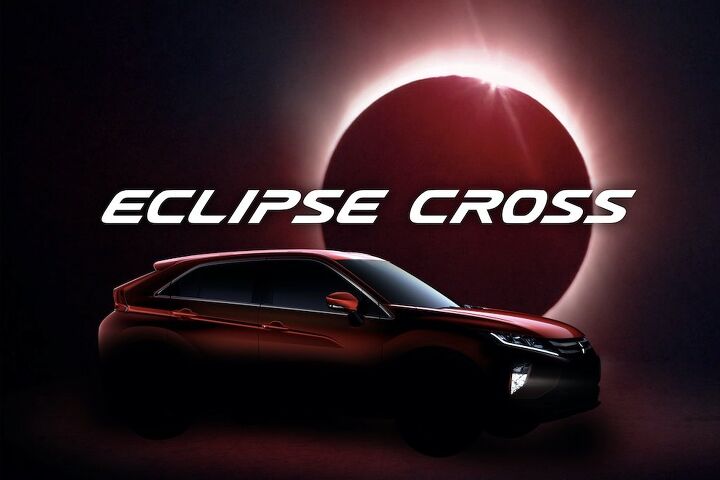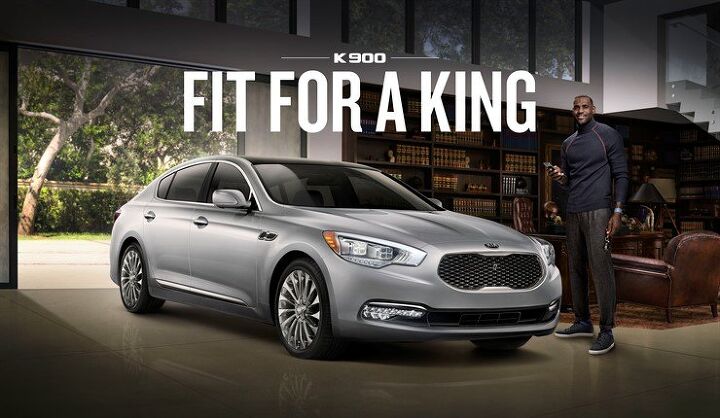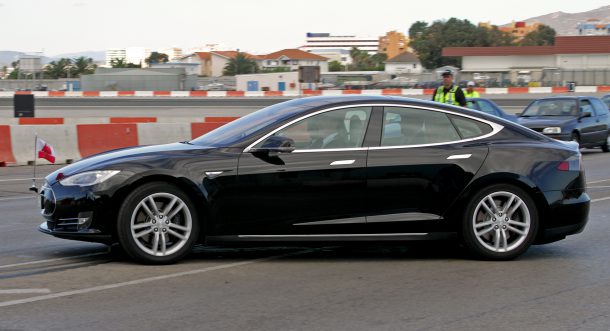#Marketing
BMW's Getting a 'New Logo' for Its Flagship Models
Interested in distinguishing its premium models from the rest of the flotsam and jetsam, BMW is launching a “new” black-and-white logo it will use to market its “flaggschiff” units around the globe. The updated look was unveiled at the Frankfurt Motor Show and will be used for the 7 series and i8 coupe, as well as the forthcoming 8 series coupe, convertible, i8 roadster and X7 SUV.
Rumored to be similar to the cheesy carbon variant of the company’s emblem found in numerous aftermarket Ebay listings, the new logo is essentially the old one, only desaturated into monochrome with the company’s full name — Bayerische Motoren Werke — written out in its entirety. However, there seems to be some confusion as to how the new logo will be used and what its heritage actually entails.
Hiring a New Marketing Agency Isn't a Sign That Mitsubishi's Leaving America
Between its peak in 2002 and the depths of the recession in 2009, Mitsubishi’s U.S. sales plunged 84 percent. Market share plunged from more than 2 percent to less than half of 1 percent. Could the company survive in America?
The loss of product gave observers even more reason to doubt the brand’s staying power. Bigger SUVs such as the Montero and Endeavor disappeared. Mitsubishi’s midsize sedan, the Galant, generated its final sales in early 2014, a decade after the Mitsubishi Diamante departed. The discontinuation of the Eclipse and Lancer Evolution spelled the end of Mitsubishi’s performance bona fides. Then Mitsubishi also ended the Lancer, leaving the Mirage G4 to fight America’s sedan battle.
Meanwhile, Mitsubishi’s plans to bolster its U.S. lineup haven’t always translated to reality. The Outlander plug-in hybrid was initially bound for the U.S. market in 2014 or 2015 — it’s still not here. As for U.S. production, which Mitsubishi’s president Osamu Masuko said in 2013 would not end, the final U.S.-built Mitsubishi rolled off the Illinois line last year.
Despite the heavy load of evidence that would support the belief that Mitsubishi Motors USA was on its death bed, Mitsubishi is on track in 2017 to sell 100,000 vehicles in the U.S. for the first time since 2007, having enjoyed five consecutive years of growth. Settling in for the long haul, Mitsubishi has also signed Mini’s old ad agency, Butler Shine Stern & Partners.
Subaru Believes Dog-focused Advertising Has Been a Large Part of Its Success
Automotive advertising has always been an amalgamation of information and hype. Carmakers use commercials to inform the public of what makes their model different and new, while simultaneously promising an intangible goodness. Mid-century ads were less specific, reassuring prospective customers of a nondescript better way of life, but modern marketing has become much more focused. If ads are to be believed, buying a car today means purchasing more than just the hardware its comprised of — you’re buying an identity.
I’m reminded of a collection of car commercials from the 1960s that essentially vowed to nerds that, if they bought a specific car, they would be pursued endlessly by attractive women. It was a bold and extremely unsubtle way to kick off the new trend.
We’ve come a long way evolved slightly since then, but the concept of identity-focused advertising is more popular than ever. In fact, Subaru attributes a large portion of its own success to marketing that closely associates the brand with good values, family, lovable mutts, and the great outdoors.
The Prestige: Airport Replaces Handicap Parking With 'Lexus-only' Spaces
We’re all familiar with the concept of executive parking spaces, and surely most of us know someone with a sign hanging in their garage that reads “Mopar Parking Only.” Both are annoying concepts highlighting one person’s perceived superiority over another but without any real consequences. After all, it’s not as if they’re stealing someone else’s space.
Thinking it might be a good idea to combine these two scenarios as part of a marketing ploy, Lexus teamed up with the Calgary Airport Authority to convert five primo parking spots into branded spaces. However, the locations they ended up replacing were designed for handicapped patrons. While that understandably didn’t go over well with travelers, you have to admit there is a certain level of prestige associated with displacing people who actually need something just because you want it for yourself.
A Loyalty Oath Moment At Dodge
It’s the stuff of which public relations nightmares are made.
For the past couple of years Dodge has sponsored Motor Trend‘s “Roadkill” show, which can be thought of as a generic white-label take on Fast N’ Loud. It’s worth noting that Dodge did several promotions with Rawlings before parting ways with him and settling for the Roadkill team; the brand appears to believe that its heartland audience is best reached through flamboyant/quasi-authentic/redneck-chic YouTube personalities. What that says about FCA’s view of its customers is an exercise best left to the reader.
This past weekend, Dodge and Roadkill teamed for “Roadkill Nights on Woodward,” a staged car show and street-drag event in Detroit. There’s been no small amount of interest in this among the company’s owner base and from what I can see the event was a rip-roaring success, chock-full of Vipers and Demons and whatnot. Whenever an automaker spends this much money on any public relations exercise, there is always a tremendous amount of data deep-diving done immediately afterwards to demonstrate ROI of the expenditure via social media visibility, buff-book coverage, and mainstream mentions. Given the big turnout both online and in real life, I’m sure Dodge and its marketing partners were looking forward to the Monday meeting where they could pat themselves on the back for a job well done.
As it turns out, this weekend was an absolute barn burner of Dodge-branded media exposure. Unfortunately, the Dodge in question wasn’t a Demon lifting its front wheels on Woodward. Instead, it was a V6-powered 2010 Challenger that was driven into a crowd of anti-white supremacist protesters in Charlottesville, Virginia, causing one fatality and multiple injuries.
The odd coincidence of a “Roadkill”-themed promotion with a Challenger-caused hit-and-run fatality in Charlottesville has pundits on both sides of America’s culture war salivating — and with this unforeseen notoriety comes an unusual, and nearly unprecedented, demand.
Drivers Are Pissed About Lyft's New Partnership With Taco Bell
Taco Bell and ride-hail company Lyft announced plans this week to debut “a unique ride-thru” experience called “Taco Mode,” which will allow patrons to request a pit stop at the nearest Taco Bell location. Lyft claims it’s the perfect option for “passengers seeking the ultimate Taco Bell experience.”
While riders can already request to be driven to the restaurant with some of the worst-maintained bathrooms imaginable, Lyft promises the app makes the overall endeavor of buying fast food “more convenient — and fun — than ever.”
Why would these companies join forces? According to the press release, it’s because they “are two like-minded brands at the forefront of technology and innovation.” Don’t laugh. After all, Taco Bell was the company that realized you could make a taco shell out of fried chicken, while Lyft was the organization that took Uber’s business model and added furry pink mustaches.
They also both serve the late-night community. The restaurant chain provides a “fourth meal” to individuals that are too drunk or stoned to cook and the ride-hailing service keeps them from endangering others by stopping them from operating a motor vehicle. On the surface, it seems like a natural fit for a genius cross-marketing opportunity — until you place yourself into the shoes of the driver plighted to slop these disgusting animals in the backseat.
Fiat Chrysler Thinks Americans Outside of California Don't Know What the Pacifica Plug-in Hybrid Is
It’s a fact that California contains half of the country’s electric vehicles and a solid chunk of America’s hybrids, but that doesn’t necessarily mean residents of the other 49 states can’t tell a plug-in hybrid from a turnip.
As all-electric range grows, plug-in hybrids have begun eclipsing conventional hybrids in the U.S. marketplace, enticing buyers with the prospect of leaving the gas engine shut off (potentially) for the whole commute. After hopping on the green bandwagon with its Pacifica Hybrid, Fiat Chrysler Automobiles was able to boast of having the only plug-in minivan in North America.
Only, it won’t boast about the “plug-in” part anywhere except California. Nope, you won’t hear the company call it a plug-in in New York City, or Seattle, or Chicago. Not in Vermont or Georgia, either. Apparently those people just can’t handle it.
QOTD: Who's Your Favorite Celebrity Huckster?
If a famous person sways your purchasing behaviour, you’re likely an idiot. Actors and other celebs rake in great coin shamelessly hocking products to the teeming masses, be it life insurance, Preparation H, overpriced jeans, or underperforming vehicles. To them, the suitcase of cash emits the siren song, not the product. (Don’t start up about athletes and sports-branded clothing. We’re not going in that direction.)
No company covets celebrity endorsements quite like automakers. Whether it’s longtime Anglophile Tom Brady shilling for Aston Martin or LeBron James’ sudden love for Kia’s spectacularly slow-selling K900, nothing gets eyes on the product faster than having someone famous stand next to it. Surely, none of us would ever fall for such a thing.
Celebrity endorsements, if you want to call it that, only bolsters a non-mouth-breather’s buying decision if it reinforces a previously held position. Already angling for a Chrysler Newport? Well, your favourite star from, say, Barney Miller, agrees it’s a sensible purchase. And several dollars less than Caprice! However, if said celebrity is someone you desire, rather than just respect or admire, it could be argued that there’s some subtle, subconscious influence at work. It it enough to tip the scales in favor of a certain product?
That’s something only you can answer.
Ad Time: Promising Sesame Street Chrysler Promotion Ruined by Guy Smiley, Big Bang Theory
Get to know me, even just a little, and you’ll quickly discover my seething hatred for the inexplicably popular and mercilessly long-running sitcom, The Big Bang Theory. Given the chance, I’d banish the writers, producers and male cast to the barren wastes of Siberia, where the overpaid hacks could atone for their sins (and remain quiet) while braving the frigid winds in search of nutrient-rich mosses and lichens.
Maybe it’s the death of the sitcom that brought us to this point. Raised on the terrific sitcoms (and some guilty also-rans) of the 1970s, 80s, and 90s, my childhood television experience was abundance in diversity. Still, despite my love for cars and guns and the like, my TV starting point, like that of so many others, was Sesame Street. America’s social barometer, it was, and continues to be.
Like now, strong options loomed large in little Steph’s brain. Never cared for Big Bird. Too big. Dull in conversation. Grover? Who is Grover really supposed to be? And frankly, I wouldn’t leave any child of mine alone with Elmo.
Still, certain characters hold a special place in my dark, shrivelled heart. Until, that is, Fiat Chrysler Automobiles got its hands on their innocent, soft upper halves.
Chevrolet's Real People Commercials Are Once Again Pitting Silverado Against F-150
With the July 10 launch of a new Chevrolet Silverado commercial, General Motors is once again using its Real People, Not Actors campaign in an attempt to tarnish the Ford F-150’s good name.
This methodology doesn’t appear to have had an impact in the marketplace in the past. Yet two years after General Motors displayed conversations between Howie Long and GM engineer Eric Stanczak discussing repair costs on the Ford F-150’s aluminum bed and one year after Chevrolet punctured a Ford F-150’s aluminum bed with 825 pounds of concrete blocks, General Motors is turning to admitted Ford F-150 owners as a means of casting aspersions on America’s top-selling full-size truck.
After earlier rounds, Ford gained ground in America’s full-size pickup truck market in 2016. Indeed, Ford is continuing to gain ground in that same market in 2017. Ford is selling more trucks than its rivals. Ford is selling more trucks with less incentivization. Ford is selling more trucks with less incentivization at higher average transaction prices.
So, GM sends the Chevrolet Silverado back to the same ol’ well.
Volkswagen of America's New Sales and Marketing Chief: Skoda's Werner Eichhorn
One month ago, former Hyundai Motor America sales vice president Derrick Hatami departed Hyundai and ended up in a similar role at Volkswagen of America: executive vice president for sales and marketing.
Hatami moved into his new office on June 12, 2017. Less than two months from now, and two years after Volkswagen’s diesel emissions scandal erupted in September 2015, Hatami’s new boss will move into his new office. Imported from Skoda, Werner Eichhorn moves to Volkswagen’s North American region as the chief sales and marketing officer.
Together with Hinrich Woebcken, who became CEO of Volkswagen in North America in April 2016, seven months after #dieselgate broke, Hatami and Werner Eichhorn form the nucleus of an all-new sales team at Volkswagen of America.
And not a moment too soon.
Uh-Oh - Like Chevrolet, Mazda's New Commercials Also Have Real People
They’ve haunted you in your sleep. “The lines down here are seamless, like classic German design,” a British fellow says about the new Chevrolet Malibu.
You overhear them during the morning news breaks as you walk to your gate at the airport. “Business in the front, party in the back,” a young woman says, describing the Chevrolet Cruze Hatchback.
“I am surprised that it’s Chevy,” a woman responds after being asked what she thinks about Bowtie victories in J.D. Power’s Initial Quality Study. You vomit a little in your mouth.
But in the eyes of General Motors, Chevrolet’s Real People, Not Actors campaign is working. And it appears Mazda thinks quite highly of the formula as well.
QOTD: How Long Should a Street Car Be Able to Run on a Track? What If It's Electric?
I doubt that very many of you have seen Robb Holland’s series over on Jalopnik about turning a salvage-title Z06 into a Pikes Peak car. That’s okay; unless you’re a particular fan of Corvettes or of Robb Holland you aren’t missing much.
At the heart of it, the series is a fairly typical exercise in what I call “Journalist Stone Soup Motorsports” — you call everybody in the world to get as much free stuff as you can and then you offer to mention them on your website. Some people are much better at this than others; Mr. Holland’s vehicular opus looks like it consumed about a thousand man-hours of free labor and maybe fifty grand worth of free stuff. Feel free to compare that to the incompetent promotional efforts of your humble author, who won an AER race last month with uh, um… some year-old, half-worn tires courtesy of Dunlop. (Thank you, Dunlop!) This is no doubt due to the fact that Robb is a handsome, well-liked television personality, whereas I’m primarily notable for being kicked out of NASA Performance Touring twice in four seasons.
There is, however, something of value in Robb’s most recent article. In the process of excusing the Corvette Z06 from overheating shenanigans (hmm… why does this sound familiar?), he asks, “Personally, I think the whole [overheating] thing is load of crap… First, how long should a street car be able to run on track before having to stop? One minute, five minutes, 100 minutes? Twenty-four hours? What’s the benchmark? A race track is a very different environment than the street. You can’t design a car to work well in both.”
It’s easy to dismiss this by pointing out all the cars that can complete SCCA and NASA sprint races with bone-stock drivetrains, but if the question isn’t relevant now, it’s about to be extremely relevant. The electric car is coming, and it’s not going to handle racing terribly well. In fact, it’s not even going to handle hot weather or off-track high speeds terribly well. So what does it need to be able to do?
New 2018 Honda Odyssey Commercial: Your Kids Are Awful, We Have A Solution
They’re monsters, fighting over a squeezable toy bus before the journey has even begun. They’re inattentive rascals, wearing headphones and tuning out their parents before Mom is even in the van. They’re instigators and agitators, wholly dependent upon parents to keep the peace.
Or are they? Are children really so bad that Honda’s very first marketing campaign for the fifth-generation 2018 Odyssey has to present a negative slant on the life of a parent?
Maybe not. But in an age in which conflict is fostered during live news coverage all day long, in which children are perpetually entertained so they don’t need to entertain themselves, in which there’s not enough time before Zoey’s pottery class and Aiden’s play date to source a conventional resolution, Honda’s Magic Slide seats produce a brilliantly eye-catching commercial, with a little help from animation.
Of course, my kids would never tussle like this.
Depressing New Lexus IS Commercial Basically Gives up on Behalf of All of Us
We’ve got more than a few years of driving remaining, don’t you think?
It’s 2017. People still grasp steering wheels, still prod throttle pedals, still check blind spots (sometimes), still use their left hand to flick a signal stalk, and still stop for red lights by firmly pressing a right foot against a brake pedal. Last I checked, in my driveway sits a two-seat convertible with a six-speed manual transmission.
But in a 30-second spot that aired repeatedly during the final game of the 2017 Stanley Cup Playoffs on Hockey Night In Canada, Lexus strikes fear into the soul of drivers everywhere in order to get you into a 2017 Lexus IS today. Today, before they — whoever “they” are — come for your manual transmissions and your steering wheels and your pedals. Before your driver’s car is replaced by an autonomous pod.
“Enjoy the thrill of driving,” Lexus says. “While you still can.”






























Recent Comments